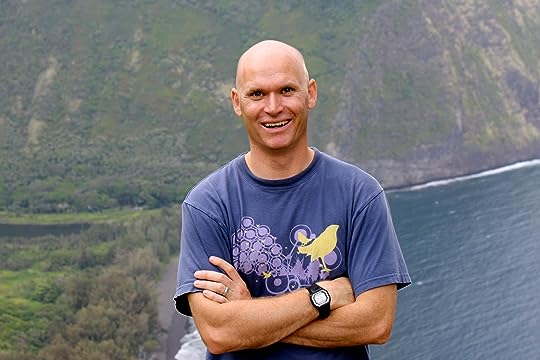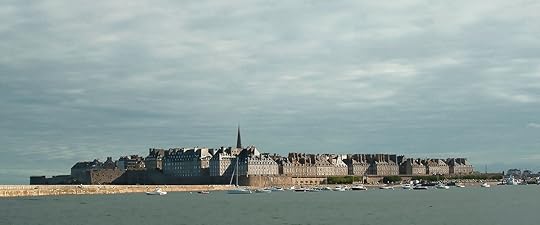What do you think?
Rate this book


544 pages, Hardcover
First published May 6, 2014
The brain is locked in total darkness of course, children, says the voice. It floats in a clear liquid inside the skull, never in the light. And yet the world it constructs in the mind is full of light. It brims with color and movement. So how, children, does the brain, which lives without a spark of light, build for us a world full of light?Marie Laure LeBlanc is a teen who had gone blind at age 6. She and her father, Daniel, fled Paris ahead of the German invasion, arriving in the ancient walled port city of Saint Malo in northwest France to stay with M-L’s great uncle, Etienne. His PTSD from WW I had kept him indoors for two decades. They bring with them a large and infamous diamond, to save it from the Nazis. Daniel had made a scale model of their neighborhood in Paris to help young Marie Laure learn her away around, and repeats the project in Saint Malo, which is eventually occupied by the German army.

Open your eyes, concluded the man, and see what you can with them before they close forever, and then a piano comes on, playing a lonely song that sounds to Werner like a golden boat traveling a dark river, a progression of harmonies that transfigures Zollverein: the houses turned to mist, the mines filled in, the smokestacks fallen, an ancient sea spilling through the streets, and the air streaming with possibility.As her father is the head locksmith for the National Museum of Natural History in Paris, Marie Laure has the run of the place. She spends a lot of time with a professor there, learning everything she can about shells, mollusks and snails.
Dr. Geffard teaches her the names of shells--Lambis lambis, Cypraea moneta, Lophiotoma acuta--and lets her feel the spines and apertures and whorls of each in turn. He explains the branches of marine evolution and the sequences of the geologic periods; on her best days, she glimpses the limitless span of millennia behind her: millions of years, tens of millions of years.Both Werner and Marie Laure are enriched by teachers and books as they grow. No nuclear families here. Marie Laure’s mother died in childbirth. The Pfennig children lost their remaining parent when father was killed in the mine.
I knew early on that I wanted her to be interested in shells. I'm standing here at the ocean right now. I've always been so interested in both the visual beauty of mollusks and the tactile feel of them. As a kid, I collected them all the time. That really imbued both "The Shell Collector" and Marie with, Why does the natural world bother to be so beautiful? For me, that's really embodied in seashells. I knew early on that I wanted her to find a path to pursue her interest in shells. I think that fits — I hope that fits — with visual impairment, using your fingers to identify them and admire them. - from the Powell’s reviewWerner’s snowy white hair alone might stand in for the entirety of the visible spectrum. (although it is described as “a color that is the absence of color.”) The dreaded prospect of being forced to work in the mines in a literally coal-black environment, the very antithesis of light, offers motivation for Werner to find another path, and coal itself offers a balance for that other form of carbon that drives Marie Laure’s father out of Paris, the one that embodies light. While black and white are often used in describing Werner’s environment, the broader spectrum figures large in his descriptions.
Werner liked to crouch in his dormer and imagine radio waves like mile-long harp strings, bending and vibrating over Zollverein, flying through forests, through cities, through walls. At midnight he and Jutta prowl the ionosphere, searching for that lavish, penetrating voice. When they find it, Werner feels as if he has been launched into a different existence, a secret place where great discoveries are possible, where an orphan from a coal town can solve some vital mystery hidden in the physical world.A nice additional touch is Marie Laure’s reading of 20,000 Leagues Under the Sea. It permeates the tale as her reading echoes events and tensions in the real world of the story.
It’s a reference first and foremost to all the light we literally cannot see: that is, the wavelengths of the electromagnetic spectrum that are beyond the ability of human eyes to detect (radio waves, of course, being the most relevant). It’s also a metaphorical suggestion that there are countless invisible stories still buried within World War II — that stories of ordinary children, for example, are a kind of light we do not typically see. Ultimately, the title is intended as a suggestion that we spend too much time focused on only a small slice of the spectrum of possibility. - from Doerr’s siteInterview by Jill Owens for Powell’s












The Written Review:Why are all prize winning books so depressing?
No denying that this one is a big boi.
But was it worth all that paper?
Click the link for my video review of the big bois in my life.
Don’t you want to be alive before you die?We follow two storylines - one set in Germany focused on Werner Pfennig, an orphan, who's always dreamed of an education.
But it is not bravery; I have no choice. I wake up and live my life. Don't you do the same?Unbeknownst to Marie-Laure, her father carries a priceless gem (or one of the three replicas) that is rumored to grant everlasting life to its keeper but nothing but misery to all others around him.
You know the greatest lesson of history? It’s that history is whatever the victors say it is. That’s the lesson. Whoever wins, that’s who decides the history. .This one was an interesting story but not an engaging one. I couldn't connect to the characters and the plot seemed to stretch on forever without making much progress.